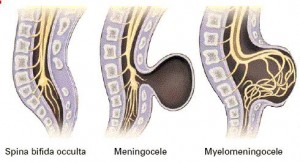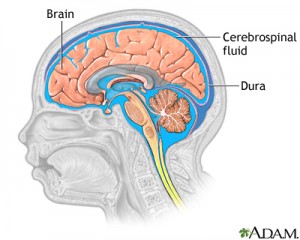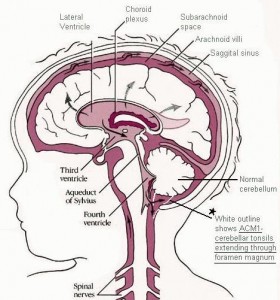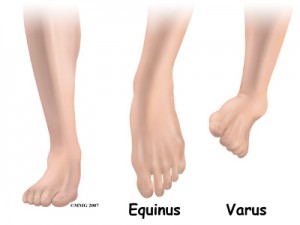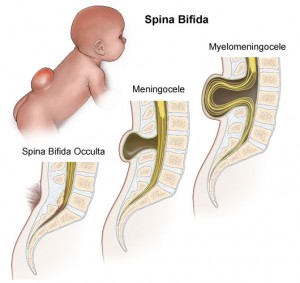Category — 2.1 Children with Nervous System Disorders: Spina Bifida
Children with Spina Bifida (SB)
Spina Bifida (SB)1 is a congenital neural tube defect (Fig. 1) where part of the spinal column does not close completely. When this happens, the membranes covering the spinal cord or the membranes and the spinal cord are exposed. Sometimes the membrane and the cord protrude out the back of the spine.
Figure 1. Congenital Neural Tube Defect
Description
The extent of the damage depends on the location and degree of the exposure or opening of the spinal column. Difficulties can range from no obvious damage to paralysis and severe brain damage. Hydrocephalus, or the buildup of CSF fluid (Fig. 2) after a leak insidethe brain, often occurs with Spina Bifida. The exact cause is unknown, but it is thought that there are many contributing factors, including, for example, the presence of a tumor.
Figure 2. CSF FLuid
Characteristics associated with Spina Bifida include the following:
- Arnold-chiari malformation (see full Glossary) (Fig. 3);
- Curvature of the spine (Fig. 4), or scoliosis;
- Foot malformations or anomalies (Fig.5);
- Heart problems;
- Problems with kidneys, bladder, rectal and anal sphincters
Figure 3. Arnold-chiari Malformation
Figure 4. Scoliosis
Figure 5. Foot Malformation
There are four forms of Spina Bifida that have to do with how parts of the brain “come out” or protrude (protrusion), or are not formed at all, as shown in this image (Fig. 6):
Figure 6. Spina Bifida
The medical description of each one of these forms is as follows2:
- Spina Bifida occulta – In this form, the vertebral arches are absent, but there is a hairy patch of skin over the defect.
- Meningenocele – In this form thereis a bulge in the lumbosacral area consisting of a meningeal sac protruding through the bone defect.
- Myelomeningocele – In this form, the sac contains malformed spinal cord tissue.
- Encephalocele – This is a protrusion of brain through a defect of the skull, usually in the occipital area.
Intervention Options
- Physiotherapy: Physiotherapist will help children develop their large muscles, use their legs, and learn how to use mobility equipment.
- IDP/AIDP: A child’s development may be monitored.
- SCD/ASCD: After age three, if the child attends a center based program, he or she may be referred to SCD/ASCD and their development may be monitored.
- Mental health: Most children with Spina Bifida do not have cognitive delays and are aware that they are different. They may have mental health issues and may need counseling or psychotherapy.
- Academic preparation: Children with Spina Bifida may need help learning how to maneuver their wheelchair or any walking equipment.
To learn about Spina Bifida in the middle childhood years, please visit the six to 12 part of this course.
1. Resources:
http://www.sbhac.ca/beta/
http://www.ninds.nih.gov/disorders/spina_bifida/spina_bifida.htm
http://kidshealth.org/parent/system/ill/spina_bifida.html
2. Source: http://www.neuropathologyweb.org/chapter11/chapter11bNTD.html
February 25, 2011 No Comments
